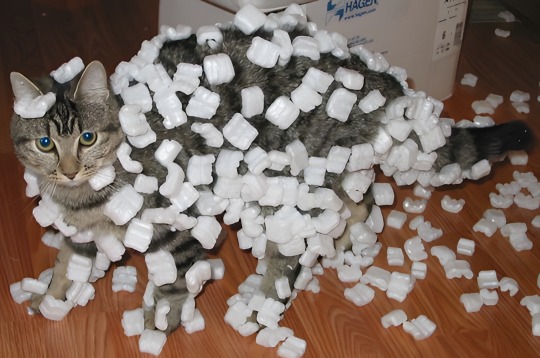#electric charge
Explore tagged Tumblr posts
Text

Static cling
“Styrofoam peanuts clinging to a cat's fur due to static electricity. The triboelectric effect causes an electrostatic charge to build up on the fur due to the cat's motions. The electric field of the charge causes polarization of the molecules of the styrofoam due to electrostatic induction, resulting in a slight attraction of the light plastic pieces to the charged fur. This effect is also the cause of static cling in clothes.” - via Wikimedia Commons
#static cling#static electricity#cat#cats#packing peanuts#styrofoam#wikipedia#wikipedia pictures#wikimedia commons#animals#catblr#cat blogging#kitty#kitties#feline#felinae#fauna#triboelectric effect#electricity#styrofoam peanuts#electric charge#physics#static#cute cats#caturday#kitty cat#cats of tumblr#tabby cat#tabby#house cat
726 notes
·
View notes
Text
"Scientists have long been fascinated by the formation of gold nuggets, often found nestled within quartz veins. New research led by Monash University geologists suggests that the process might be even more electrifying than we previously thought—literally.
Gold nuggets, prized for their rarity and beauty, have been at the heart of gold rushes for centuries.
The study is led by Dr. Chris Voisey from the Monash University School of Earth Atmosphere and Environment and will be published in Nature Geoscience."
"The research team tested a new concept, piezoelectricity. Quartz, the mineral that typically hosts these gold deposits, has a unique property called piezoelectricity—it generates an electric charge when subjected to stress. This phenomenon is already familiar to us in everyday items like quartz watches and BBQ lighters, where a small mechanical force creates a significant voltage. What if the stress from earthquakes could do something similar within the Earth?"
""The results were stunning," said study co-author Professor Andy Tomkins, from the Monash University School of Earth, Atmosphere and Environment.
"The stressed quartz not only electrochemically deposited gold onto its surface, but it also formed and accumulated gold nanoparticles," he said.
"Remarkably, the gold had a tendency to deposit on existing gold grains rather than forming new ones.""
continue reading
#earth#earth science#electricity#charge#energy#electrochemistry#geology#earthquakes#quartz#gold nuggets#atmosphere#nature#minerals#piezoelectricity#electric charge#stress#force#voltage#electric universe
4 notes
·
View notes
Text

2501051719 3
#Akila#Megapolis#Solar#Panel#Cars#Taxi#Plants#Green#Energy#Square#Structures#wide space#clean energy#good living#good vibes#low traffic#parking spots#electric charge#beat shops#good district#good view#perfect timing#public transport#many trees#good place#meditation#clear sky#sunrise#city taxi#not many cars
1 note
·
View note
Text

The Science Manuscripts of Satyendra Sunkavally, page 38.
#chromosomal fragility syndrome#alcohol#cancer#smoke#acetone#diabetes#bone marrow#radiation#protein denaturation#cachexia#clothing factors#electric charge#tetanus#iron
1 note
·
View note
Text
Does Grounding or Earthing Actually Work?

Grounding involves direct physical contact with the earth, which may support overall health.
Walking barefoot or using grounding mats can balance the body’s electrical energy.
Grounding may reduce inflammation, improve sleep, and lower stress levels.
It helps stabilize the body’s natural energy by connecting to the earth’s surface.
Several studies suggest grounding can boost mood and energy levels.
Introduction
Grounding, also known as earthing, is a practice that involves connecting physically with the earth’s surface.
Whether it’s walking barefoot on grass, sand, or soil, grounding allows the body to absorb the earth’s electrical charge.
What is Grounding?

Grounding is simply the act of making direct contact between the body and the earth. The earth carries a natural, negative electrical charge.
When you connect with it, free electrons are absorbed, helping to balance the body’s electrical charge.
Health Benefits of Grounding
Blood Pressure:
Grounding may also have positive effects on blood pressure by supporting the body’s natural ability to regulate cardiovascular function.
The practice of grounding helps reduce blood viscosity and red blood cell aggregation, which lowers the resistance to blood flow, potentially easing strain on the heart.
This improvement in blood flow can result in a reduction in blood pressure levels.
Reduced Inflammation:

Research suggests that grounding may help reduce inflammation by neutralizing free radicals, which can decrease oxidative stress in the body.
Improved Sleep:
Grounding has been shown to regulate the body’s sleep-wake cycles, helping people experience more restful and consistent sleep.
Enhanced Mood:
Connecting with the earth may help lower stress by regulating cortisol, a hormone that affects mood and anxiety levels.
Increased Energy:
Grounding can potentially help balance the body’s energy, leaving people feeling more refreshed and alert after spending time connected to the earth.
Methods of Grounding

Grounding can be done in several simple ways:
Walking Barefoot: Walking barefoot on grass, soil, sand, or even concrete is one of the most effective ways to ground. It allows for direct contact with the earth’s surface.
Using Grounding Mats or Sheets: If you are unable to go outside, grounding mats and sheets offer a way to experience grounding indoors. These devices mimic the electrical connection you would get by walking on natural surfaces.
Water-Based Grounding: Standing in natural bodies of water such as lakes, rivers, or oceans allows for grounding through water, as it is a conductor of electricity and facilitates electron absorption from the earth.
Science Behind Grounding
The earth’s surface carries a negative electrical charge, and human bodies are conductive.
When direct contact with the earth is made, electrons are absorbed, which helps reduce the buildup of positive charges that may contribute to inflammation and stress.
Some research suggests that grounding can lower blood viscosity, which supports heart health.
There is also evidence that grounding can help normalize cortisol levels, which helps the body manage stress more effectively.
Common Misconceptions About Grounding
Not a Replacement for Medical Care: Grounding is seen by some as a complementary wellness practice, not a substitute for medical treatment. It can be one part of an overall wellness approach, but not a cure for medical conditions.
Grounding vs. Other Wellness Practices: Grounding involves direct physical contact with the earth’s surface, which makes it distinct from practices like meditation or yoga, which focus more on mental and physical balance without requiring contact with nature.
Grounding In Daily Life

Grounding is simple and can be done daily:
Morning Walks: Take short walks barefoot on grass, sand, or other natural surfaces to connect with the earth early in the day.
Grounding at Home: Use grounding mats or sheets while working or relaxing indoors if going outside isn’t possible.
Post-Workout Grounding: After exercise, spend time grounding to help your body recover and balance its energy levels.
Conclusion
Grounding is a simple and natural practice that may offer physical and mental health benefits. From improving sleep to reducing inflammation, connecting with the earth’s surface through methods like walking barefoot or using grounding mats can support overall wellness. Grounding offers an easy way to feel more balanced and energized.
FAQs
What is grounding, and how does it work?
Grounding is the process of making direct contact with the earth, allowing the body to absorb electrons that help stabilize its electrical charge.
Can grounding improve sleep?
Yes, grounding has been linked to improved sleep by regulating the body’s natural sleep-wake cycles and lowering stress.
What are some indoor grounding options?
Grounding mats and sheets are good options for grounding indoors, offering a similar connection to the earth’s energy.
How long should I ground each day for benefits?
Grounding for 20-30 minutes a day may help reduce inflammation and improve energy levels.
Are there any risks with grounding?

Courtesy: Menigoz, W., Latz, T.T., Ely, R.A., Kamei, C., Melvin, G. and Sinatra, D., 2020. Integrative and lifestyle medicine strategies should include Earthing (grounding): Review of research evidence and clinical observations. EXPLORE, [online] 16(3), pp.152–160. https://doi.org/10.1016/j.explore.2019.10.005.
Research
Ayoub, J.-C. (2002). A comparison of three measures of the stress response: Endocrinological, psychological, and electrodermal (Ph.D. Dissertation, California Institute for Human Science).
Chevalier, G., Patel, S., Weiss, L., Chopra, D., & Mills, P. J. (2019). The Effects of Grounding (Earthing) on Bodyworkers’ Pain and Overall Quality of Life: A Randomized Controlled Trial. EXPLORE, 15(3), 181-190. https://doi.org/10.1016/j.explore.2018.10.001
Chevalier, G., Sinatra, S.T., Oschman, J.L. and Delany, R.M., 2013. Earthing (Grounding) the Human Body Reduces Blood Viscosity—a Major Factor in Cardiovascular Disease. The Journal of Alternative and Complementary Medicine, [online] 19(2), pp.102–110. https://doi.org/10.1089/acm.2011.0820.
Chevalier, G. , Melvin, G. and Barsotti, T. (2015) One-Hour Contact with the Earth’s Surface (Grounding) Improves Inflammation and Blood Flow—A Randomized, Double-Blind, Pilot Study. Health, 7, 1022-1059. https://www.scirp.org/journal/paperinformation?paperid=58836
Chevalier, G. (2014). Grounding the Human Body Improves Facial Blood Flow Regulation: Results of a Randomized, Placebo Controlled Pilot Study. Journal of Cosmetics, Dermatological Sciences and Applications, 4, 293-308. doi: 10.4236/jcdsa.2014.45039.
Chevalier, G. (2015). The Effect of Grounding the Human Body on Mood. Psychological Reports. https://doi.org/10.2466/06.PR0.116k21w5
Chevalier, G., Mori, K. and Oschman, J.L. (2006). The effect of earthing (grounding) on human physiology. European Biology and Bioelectromagnetics, 2(1), 600-621.
Chevalier, G., Sinatra, S.T., Oschman, J.L., Sokal, K. and Sokal, P. (2012). Earthing: Health Implications of Reconnecting the Human Body to the Earth’s Surface Electrons. Journal of Environmental and Public Health, 2012, 1-8. https://doi.org/10.1155/2012/291541.
Ghaly, M., & Teplitz, D. (2004). The biological effects of grounding the human body during sleep, as measured by cortisol levels and subjective reporting of sleep, pain, and stress. Journal of Alternative and Complementary Medicine, 10, 767-776.
Koniver, L. (2023). Practical applications of grounding to support health. Biomedical Journal, 46(1), 41-47. https://doi.org/10.1016/j.bj.2022.12.001
Menigoz, W., Latz, T.T., Ely, R.A., Kamei, C., Melvin, G. and Sinatra, D. (2020). Integrative and lifestyle medicine strategies should include Earthing (grounding): Review of research evidence and clinical observations. EXPLORE, 16(3), 152-160. https://doi.org/10.1016/j.explore.2019.10.005.
Oschman, J. L. (2007). Can electrons act as antioxidants? A review and commentary. Journal of Alternative and Complementary Medicine, 13, 955-967.
Oschman, J.L. (2023). Illnesses in technologically advanced societies due to lack of grounding (earthing). Biomedical Journal, 46(1), 17-29. https://doi.org/10.1016/j.bj.2022.10.004.
Oschman, J., Chevalier, G. and Brown, R. (2015). The effects of grounding (earthing) on inflammation, the immune response, wound healing, and prevention and treatment of chronic inflammatory and autoimmune diseases. Journal of Inflammation Research, 83. https://doi.org/10.2147/jir.s69656.
Sinatra, S. T., Sinatra, D. S., & Chevalier, G. (2023). Grounding – The universal anti-inflammatory remedy. Biomedical Journal, 46(1), 11-16. https://www.ncbi.nlm.nih.gov/pmc/articles/PMC10105021/
Sokal, K. and Sokal, P. (2011). Earthing the Human Body Influences Physiologic Processes. The Journal of Alternative and Complementary Medicine, 17(4), 301-308. https://doi.org/10.1089/acm.2010.0687.
Sokal, K. and Sokal, P. (2012). Earthing the Human Organism Influences Bioelectrical Processes. The Journal of Alternative and Complementary Medicine, 18(3), 229-234. https://doi.org/10.1089/acm.2010.0683.
0 notes
Photo

'Couple' Hak-ju Lee made a slip of the tongue to Kim Jong-tae prison
Source: k-star-holic.blogspot.com
0 notes
Text
Table 2.2 lists several derived SI units that are important in chemistry.

"Chemistry" 2e - Blackman, A., Bottle, S., Schmid, S., Mocerino, M., Wille, U.
#book quotes#chemistry#nonfiction#textbook#si units#systeme international#measurement#area#volume#speed#velocity#acceleration#density#specific volume#force#pressure#energy#power#electric charge#electric potential#newton#pascal#joule#watt#coulomb#volt
1 note
·
View note
Text
Chapter 18: The Magnetic Field of a Moving Charge
18.1 Introduction In this chapter, we will discuss the magnetic field produced by moving charges, such as electrons and ions, and how it affects the motion of other charged particles. Understanding the magnetic field of a moving charge is essential for various applications, including the design of particle accelerators and the analysis of plasma behavior in fusion reactors. 18.2 Biot-Savart…
View On WordPress
0 notes
Text

Yael Bar Tur
#israel hamas war#israel#there is no law that states a company must provide electricity free of charge actually
571 notes
·
View notes
Text

#arcane#viktor#jayce talis#jayvik#arcane fanart#arcane viktor#viktor arcane#lucien draws#inspo from fishscales#I’ve missed them#did i draw the autism men instead of my research paper about autism. maybe.#HEXHOMO SAW MY ART EHAT I CANT IM FREAKIN OUT OH MY GOD OHHHHHHAH my god did i make it???#feeling like an electric charge just zapping through my synapses
832 notes
·
View notes
Text
Yes the slamming against the wall, yes the push onto the couch, yes the pulling the underwear with his teeth, yes the nod of consent. Absolutely!! They're very deserved popular highlights of a scene that is perfect from start to end.
But as someone who had rewatched it on loop for days, can I offer you some more? It`s not like we have achieved full insanity with this scene yet. There`s more potential to it. There`s infinite potential to it.
So here are my personal highlights:
Joke's smug grin before kissing Jack

Jack's indentations on Joke's torso

The force with which Jack threw those pants,, (and Joke. And Joke's little expectant expression for the cherry on top)

Joke wetting his lips before kissing Jack again

Jack grabbing Joke's chin to pull him back into a kisskjdfl,kmnd,lmddf (this one made me Especially insane)

Joke biting his lips AND Jack once again grabbing Joke's chin like THAT I swear to god I fully expected a small slap after it I think I'd have instantly passed away if it happened

Am I the only one who lost their mind for these extremely specific and small details? No? Good.
#jack & joker#jack and joker: u steal my heart#jack & joker: u steal my heart!#jack and joker#jack & joker the series#jackjoker#waryin#yinwar#gif#series#mine#bro I have watched a zillion different LA BLs throughout all my BL life (over 20 years)#NONE of them delivered what this scene delivered.#It's just perfect bc it's raw and it feels real#no cringe#no first time shojo sparkles in it#just electric sparks in a very charged moment#fire emoji fire emoji fire emoji fire emoji
260 notes
·
View notes
Video
youtube
Plasmagoria
“The gaslight era is over. Today, a flood of new observations have the experts over at Big Space in a tizzy, inventing ad-hock explanations. A new view of the universe has emerged, one based on the modern discoveries of the electrical properties of plasma.
An apple fell on Isaac Newton—he conceived the Gravity Universe. An aurora fell on Kristian Birkeland—he conceived the Plasma Universe. While the story of Newton is apocryphal, it was in the early 1900s when Birkeland trekked to the Norwegian Arctic, stood under the Aurora Borealis, and took measurements that revealed the presence of electric currents.
Plasma is any substance that contains charged particles—negatively charged electrons, positively charged ions, or dust particles that have an excess of either electrons or ions. Fluorescent and neon lights are plasma. Lightning is plasma. Earth’s magnetosphere, the solar wind, and the sun itself are plasma. Those glowing nebulas in space—mistakenly labeled giant clouds of dust and gas; mainly star-forming regions like the "Pillars of Creation" in the Eagle Nebula—plasma. Full stop.
EU advocate Matt Finn reminds us that as we look further out with the help of miraculous new instruments and technologies—such as the James Webb Space Telescope—it's undeniable we live in an electrically charged Universe.”
#plasmagoria#protoplasm#plasma#plasma physics#physics#charge#discharge#electric universe#electric charge#energy#electricity#density#matter#electrons#ions#magnetism#electromagnetism#magnetic field#rotation#circuits#life
1 note
·
View note
Text



Been a hot minute since I did one of these. Tried something a bit more ambitious this time. Not perfect, but I'm still pretty happy with it.
Included a couple of closer crops cause compression really annihilated this one lol
277 notes
·
View notes
Text
My complex decided to do roofing. Because why not now. In December. The ideal time for roofing obviously. My complex is lousy with Fucking Massive Trucks and the sounds of hammering.
It’s not my fav.
#ramblies#they are flinging old bits off the roofs very haphazardly#and it’s not that I don’t want a nicer roof#but I’d really rather not puncture a tire on my new electric car that doesn’t come with a spare#and also I can’t even turn my car around to charge it because there’s literally four massive trucks in the way
280 notes
·
View notes
Text

Trump to shut down all 8,000 EV charging ports at federal govt buildings
The Trump administration is shutting down EV chargers at all federal government buildings and is also expected to sell off the General Services Administration‘s (GSA) newly bought EVs.
GSA, which manages all federal government-owned buildings, also operates the federal buildings’ EV chargers. Federally owned EVs and federal employee-owned personal EVs are charged on those 8,000 charging ports.
The Verge reports it’s been told by a source that plans will be officially announced internally next week, and it’s seen an email that GSA has already sent to regional offices about the plans:
“As GSA has worked to align with the current administration, we have received direction that all GSA-owned charging stations are not mission-critical.”
The GSA is working on the timing of canceling current network contracts that keep the EV chargers operational. Once those contracts are canceled, the stations will be taken out of service and “turned off at the breaker,” the email reads. Other chargers will be turned off starting next week.
“Neither Government Owned Vehicles nor Privately Owned Vehicles will be able to charge at these charging stations once they’re out of service.”
Colorado Public Radio first reported yesterday that it had seen the email that was sent to the Denver Federal Center, which has 22 EV charging stations at 11 locations.
122 notes
·
View notes
Text

Big cat
#ft my poorly drawn monstera leaves for vibe#I was thinking abt shinx and luxray like. I know theyre supposed to be lions but I feel like cheetah or serval would work well too#like with electricity and stuff. wouldnt speed and agility make more sense for an electric type? esp a cat shaped electric type?#maybe it would be ok for luxray to be heavy built because itd be really big by then. but I thought hey it would be cool if its preevolutions#could focus on speed for escaping. escaping and hunting yknow#maybe this is just because I watched a cheetah documentary last night and thought they were cool#I also have a hc that luxray can charge up electricity and make its whole body glow like an x ray#like you can see it’s bones through the blue parts of skin. either as a threat display or courtship#the shinier and bluer the fur is the better you can see the bones. which would mean its feeding itself well#but Im not a biology expert Im just using what I learned from birds LOL#so sososo normal abt luxray line (is my favorite pokemon)#my art#myart#pokemon#illustration#shinx#Luxio#luxray#luxray line
2K notes
·
View notes